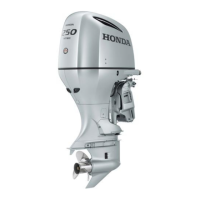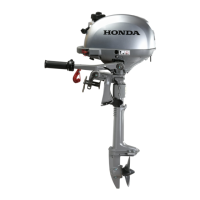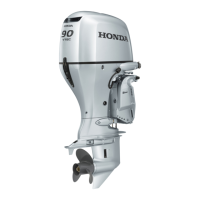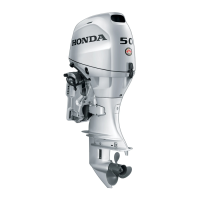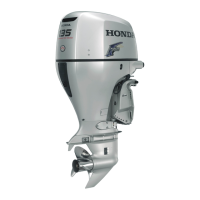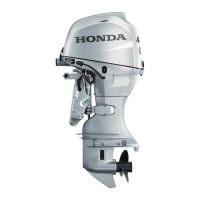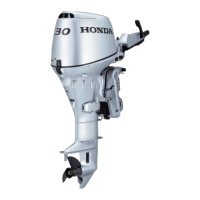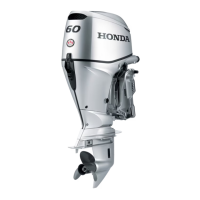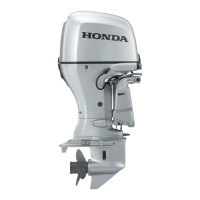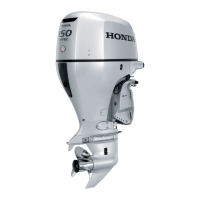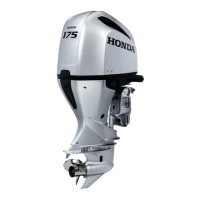Do you have a question about the HONDA marine BF225A and is the answer not in the manual?
Detailed dimensions and weights for BF175A and BF200A/BF225A outboard motors.
Specifications related to the frame, including transom height, tilting angle, and swivel angle.
Chart detailing types, shaft lengths, and features of BF175A outboard motors.
Detailed specifications for the BF200A and BF225A engines, including displacement, power, and lubrication.
Specifications for the lower unit, including clutch, gear ratio, and oil capacity.
Explanation of symbols used in the manual for procedures and references.
Information on where to find the engine and product identification numbers.
Standards for engine parts, including valve clearance, piston O.D., and ring groove width.
Table of specified torque values for various engine and gear case bolts and nuts.
List of special tools required for specific procedures with their part numbers and applications.
Diagnostic flowcharts for engine problems like hard starting and rough running.
Diagrams showing the routing of various cables and harnesses on the engine.
Illustrations and labels for routing various tubes, including fuel and water lines.
Instructions and diagrams for applying marine grease to specific parts for lubrication.
Regular service schedule for the outboard motor, detailing items and intervals.
Procedures for checking and changing the engine oil, including oil level and capacity.
Instructions for replacing the engine oil filter, including torque specifications.
Procedures for inspecting, adding, and replacing gear case oil.
Inspection, cleaning, and replacement of spark plugs, including gap measurement.
Procedure for inspecting and adjusting valve clearance with specified cold engine values.
Instructions for thermostat removal, installation, and inspection, including opening temperatures.
Procedures for inspecting, removing, and reassembling the low-pressure fuel strainer.
Instructions for replacing the high-pressure fuel strainer, including relief procedures.
Inspection and adjustment procedures for engine idling speed and idle control system.
Adjustment procedures for throttle control cables and links to ensure proper operation.
Inspection and adjustment of the shift control cable, including alignment checks.
Procedures for inspecting, adjusting, and installing the timing belt.
Inspection of the alternator belt for tension and deflection, and adjustment procedures.
Disassembly and adjustment procedures for the engine damper hook.
Procedures for removing and installing the front separate cover.
Procedures for removing and installing the electric parts cover.
Removal procedures for the left and right engine under covers.
Removal and exploded view of the cover lock cable and engine cover bracket.
Procedures for removing and installing the front lock assembly and front cover bracket.
Removal/installation and exploded view of the engine cover bracket.
Important precautions for PGM-FI system troubleshooting and ECM handling.
Diagram showing vacuum connections for the PGM-FI system.
Electrical circuit diagram for the PGM-FI system.
Guide for troubleshooting PGM-FI system issues using MIL blinking codes.
Procedures for relieving fuel pressure, measuring fuel pressure, and inspecting fuel lines.
Inspection and replacement of fuel injectors and the fuel pressure regulator.
Disassembly and installation of the high-pressure fuel pump and vapor separator.
Removal, inspection, and exploded view of the low-pressure fuel pump.
Testing and replacement procedures for the high-pressure oil switch.
Testing and replacement procedures for the low-pressure oil switch.
Replacement procedure for the knock sensor.
Replacement procedure for the Engine Coolant Temperature (ECT) sensor.
Replacement procedure for overheat sensors 1 and 2.
Replacement procedure for the Idle Air Control (IAC) valve.
Replacement procedure for the Intake Air Temperature (IAT) sensor.
Replacement procedure for the Manifold Absolute Pressure (MAP) sensor.
Replacement procedure for the Heated Oxygen Sensor (H02S).
Replacement procedure for the Barometric (BARO) sensor.
Replacement procedure for the Crankshaft Position (CKP) sensor.
Replacement procedure for the Top Dead Center (TDC) sensors 1 and 2.
Operation check and replacement of the VTEC solenoid valve for BF225A models.
Exploded view and removal/installation procedures for the silencer case.
Procedures for removing, inspecting, cleaning, and installing the throttle body.
Procedures for removing, testing, and installing the intake manifold.
Procedures for removing, exploded view, and installing the exhaust manifold.
Inspection, removal, disassembly, and assembly procedures for the alternator.
Procedures for removing, exploded view, degreasing/cleaning/lubrication, and installation of timing belt components.
Step-by-step instructions for removing the engine, including disconnecting components.
Exploded view diagram showing parts of the engine mount case and related hardware.
Procedures for installing the engine assembly, including torque specifications and alignment.
Diagram illustrating the water circulation path within the engine, including thermostat and manifolds.
Procedures for removing and installing the water jacket, emphasizing gasket replacement.
Disassembly and reassembly instructions for the relief valve.
Disassembly and reassembly procedures for the flush valve.
Steps for removing the cylinder head assembly, including component removal and timing belt adjustments.
Procedures for disassembling the cylinder head, including rocker arm and camshaft removal.
Inspection procedures for valve springs, valve face/stem O.D., valve guide I.D., and clearances.
Procedures for replacing valve guides, including chilling and reaming steps.
Instructions for reconditioning valve seats using specialized cutters for smooth and concentric seats.
Exploded view and steps for reassembling the cylinder head, including lubrication points.
Procedures for installing the cylinder head assembly, including torque specifications and gasket replacement.
Steps for removing the oil pump assembly and flywheel, including relevant parts.
Exploded view and steps for disassembling the oil pump assembly.
Inspection procedures for oil pump body, rotors, and clearances with standard and service limit values.
Exploded view diagram of the flywheel and related components for removal and installation.
Procedures for installing the flywheel, flywheel boss, and reassembling the oil pump.
Exploded view and installation procedures for the oil filler extension.
Steps for disassembling the crankcase cover, crankshaft, and pistons.
Inspection of piston skirt O.D., cylinder I.D., and piston-to-cylinder clearance.
Procedure for selecting crankshaft main and connecting rod bearings based on code numbers.
Exploded view of the cylinder block, crankshaft, and related components.
Procedures for reassembling pistons, rings, and crankshaft components.
Procedures for removing and installing the propeller, including torque and split pin details.
Steps for removing the gear case assembly, including tilt and shift rod procedures.
Disassembly procedures for the water pump and shift rod.
Removal and installation of the propeller shaft holder assembly.
Removal of clutch shifter, shift slider, and related components.
Disassembly procedures for the vertical shaft and bevel gear assembly.
Procedures for selecting and calculating shim thickness for forward bevel gear and thrust shim.
Diagrams showing the correct position of shims for LD, XD, XXD and XCD, XXCD types.
Procedures for adjusting forward bevel gear backlash and checking thrust clearance.
Removal procedures for the lower rubber motor mount and extension case.
Removal and installation procedures for the extension case and related components.
Procedures for removing the oil pan, exhaust pipes, and water tubes.
Disassembly procedures for the mount case, upper mount rubber, and shift shaft A.
Procedures for removing and installing the swivel case and stern bracket assembly.
Disassembly procedures for the power trim/tilt assembly, stern bracket, and swivel case.
Disassembly procedures for the swivel case and mount frame.
Disassembly procedures for the power trim/tilt assembly components.
Removal and installation procedures for the optional steering rod.
Disassembly and assembly of the optional remote control box.
Disassembly and assembly procedures for the optional control panel.
Procedures for removing and installing the remote control cables.
Removal and installation procedures for the throttle arm and shift link bracket.
Procedures for removing and installing the shift arm, link rod, and neutral switch.
Diagrams showing the location of key electrical components on the engine.
Removal and inspection procedures for the PGM-FI main relay and power tilt relay.
Procedures for removing and installing the Engine Control Module (ECM).
Procedures for removing, inspecting, and installing the starter motor.
Inspection procedures for the ACG fuse box and individual fuses.
Procedures for removing and installing switch panels and indicator wire harnesses.
Inspection procedures for ignition switch, emergency stop switch, and warning buzzer.
General overview of the PGM-FI system, its controls, and self-diagnosis function.
Diagram showing the interconnected components of the PGM-FI system.
Explanation of basic ECM controls for fuel injection, ignition timing, and idle air control.
How the ECM makes corrections to fuel injection using various sensor signals.
Overview of ECM controls for systems like VTEC, fuel cut solenoid valve, and high-pressure fuel pump.
How the ECM determines and controls ignition timing based on engine conditions.
How the IAC valve maintains optimum idle speed by adjusting bypass air.
Function of the alert/warning system using lights and buzzers for system abnormalities.
Table detailing indicator light and buzzer operations based on engine conditions.
How the alternator warning system detects and indicates faults like power generation failure.
System operation when water level sensor detects excess water in the separator.
How the PGM-FI system sounds the buzzer for anomalies detected by self-diagnosis.
How the ECM detects abnormal oil pressure and reduces engine speed.
How the overheat sensor signals ECM, causing warnings and engine speed reduction.
Function of the fuel line cut solenoid valve in preventing vapor lock.
Function of the IAB system in controlling intake air for optimized engine performance.
How the VTEC system switches valve timing and lift for optimal engine performance.
Wiring diagram for the top mount and panel mount control box.
Wiring diagram for the side mount control box.
| Rated Power | 225 HP @ 5500 RPM |
|---|---|
| Ignition System | MicroComputer Programmed |
| Starting System | Electric |
| Lubrication System | Wet Sump |
| Cooling System | Water Cooled |
| Trim Range | -4° to +16° |
| Tilt Range | 72° |
| Recommended Fuel | Unleaded Gasoline (86 Octane) |
| Steering | Remote |
| Exhaust | Through Propeller |
| Bore & Stroke | 89 mm x 3.5 in |
| Full Throttle RPM Range | 5000 - 6000 rpm |
| Valve Train | SOHC |
| Fuel Delivery | Programmed Fuel Injection |
| Alternator Output | 90 amp |
| Shaft Length | L, X |
| Engine Type | 4-Stroke SOHC 24-Valve V6 |
| Displacement | 3, 583 cc (219 cubic inches) |
